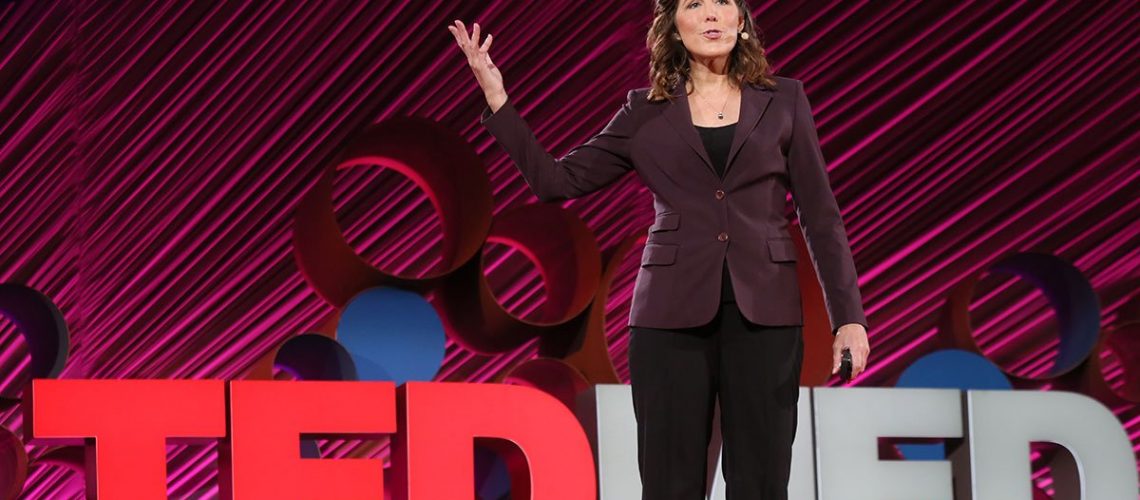At no time in human history has our species been so bombarded by stuff designed to get us hooked. Companies compete on the very basis of creating evermore habit-forming products and it's no different with our food.
Sugar scientist and UCSF professor of health policy Laura Schmidt questions whether consumers really do have freedom of choice – and what policymakers can learn from corporations in nudging consumers toward healthier behaviors.
TED Talk by Laura Schmidt
Key Takeaways
At no time in human history has our species been so bombarded by stuff designed to get us hooked. Companies compete on the very basis of creating evermore habit-forming products and it’s no different with our food.
Food corporations hire scientists to engineer the most irresistible habit-forming foods. Sugar is currently their go-to ingredient these guys have flipped the script on us.
They are using the very brain imaging technologies that we use to try to find cures for addiction, only they put people in the MRI machine and feed them Dorito chips to figure out ways to tweak the recipe to make it even more habit-forming than it already is.
So here’s my question to you when you live in a world that is surrounding you on a 24/7 basis with food products scientifically engineered to be habit-forming. Do you really have freedom of choice?
Most addictive substances are actually quite safe in their natural form—heroin comes from poppy seeds, cocaine from the coca plant, alcohol from fruits and grains.
- For centuries farmers high up in the Andes Mountains have chewed coca leaves, it’s a tradition. It’s a mild stimulant like drinking a cup of coffee, it helps them work longer hours and cope with the high altitudes. Probably the worst thing that can happen to you after a lifetime of chewing coca leaves maybe you’ll get bad teeth.
Things do get really bad when we industrialize the coca production process. When we learned how to refine the coca plant down into its most concentrated form—a little rock of white powder—that’s when the humble coca leaf becomes the lethally addictive drug we know as crack.
Up until the 20th century, cocaine was actually an innocent domesticated white powder, just like sugar is today. People put it in everything. You could go to your drugstore and and buy it in a soothing tonic, people put it in cough syrup, and gave it to their kids.
Coca-cola is one of the most successful products in modern history. It was formulated in the 1880s and the company’s founders were so proud of their special recipe that they vowed never to change it, but at one time in history the coca-cola corporation was forced to change its recipe.
That was in 1903 when the political current, the tide was shifting away from cocaine eventually to make it an illegal drug. That’s when coca-cola took the cocaine out of the coke, and just replaced it with a different addictive substance namely caffeine.
So here you have a concentrated dose of sugar combined with a concentrated dose of caffeine—double the pleasure double the chances we’ll get hooked.
The fact is as long as food corporations aren’t breaking narcotics laws, they can do pretty much whatever they want to formulate their products to make them even more habit-forming.
When it comes to food to process food and sugar we’re all living in an obstacle course. It’s on every corner, in every store, and in every workplace. 74% of the Foods in your grocery store have sugar added to them stuff that doesn’t even taste sweet.
So why do I care about this so much? It’s actually not the rising rates of obesity worldwide that keeps me up at night, it’s two other very disturbing trends and the first is the appearance of adult diseases in children.
- Type-2 diabetes is linked to heavy sugar consumption in especially sugary drinks. It’s called adult onset diabetes because in my parents generation we only saw it in adults. Today one out of four American teenagers is pre-diabetic or diabetic.
- Next is the appearance of whole new diseases that seem to come out of nowhere. The diagnosis non-alcoholic fatty liver disease didn’t even exist until 1980. Again a condition linked to heavy sugar consumption. It’s going to be the leading cause of liver transplantation.
This is the global warming of human health. These trends are warning signs like melting icebergs and rising sea levels. They’re telling us that there’s something very wrong with our food environment. Our food supply is making some of us very sick.
The solutions to this situation are easily within our reach. Everybody always says educate the public in healthy choices, but we know that doesn’t work. If it worked then why would 48% of Americans still be drinking a sugary drink or more a day.
The fact is I could say until I’m blue in the face don’t drink that stuff, it’s unhealthy. You already know that, but when you live in a sugar saturated environment, more often than not you’ll probably just reach for what’s been put in front of you and if it’s a concentrated source of pleasure—a product carefully engineered with white powders to get you hooked—that puts a huge burden on you all the time to say no and many of us don’t.
So what do we do about this problem how do we fix it the solutions are actually remarkably simple. Small changes can add up to big shifts in the environment we know this from decades of research on addictive substances.
We really would all like to believe that we’re in charge, that we have complete freedom over what we eat, but how free can we be living in a saturated environment. One that continuously surrounds us with food products carefully engineered to get us hooked and keep us coming back for more.
We can do so much better than this. We don’t have to live in an environment that is bred to get us fat and then blames us for the health consequences in the medical bills. We don’t have to sit by and watch our children suffer from diseases of adulthood. We can rerigged this environment to make it safe. It’s not about personal choice anymore it’s about our public choice.

